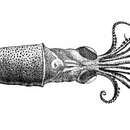Comprehensive Description
provided by Smithsonian Contributions to Zoology
Valbyteuthis danae Joubin, 1931
Valbyteuthis danae Joubin, 1931, p. 188.—Roper and Young, 1967, p.l.
DESCRIPTION.—The mantle is cylindrical anteriorly, but tapers rapidly posteriorly; the muscular portion terminates at roughly the midpoint of the fins. The pen is broken at the posterior end of the fins, so its full length is unknown. The free margin projects slightly at the nuchal and ventral mantle locks.
The fins are large (52% of the M.L. in length) and muscular. Each is nearly semicircular and has free anterior and posterior lobes.
The funnel reaches to approximately the level of the middle of the eyes. The funnel locking-cartilage has an oval depression and a distinct antitragus. This opposes a cartilage on the mantle that is shaped like a human nose with a single nostril; the latter locks with the antitragus. The dorsal pad of the funnel organ is nearly triangular, but has a slight posterior indentation. The ventral pads are oval and very large. There is no funnel valve.
The head is elongate and broadest posteriorly. The bridles and cephalic vein are prominent on the ventral surface of the head up to the level of the middle of the eyes. The head has been damaged; no other details can be ascertained.
The arms are slender and delicate. The arm formula appears to be IV>III>II>I; however, all arms have been damaged and it is impossible to get accurate measurments. All of the arms have low trabeculate protective membranes and biserial suckers. On arms I—III, the suckers near each arm base have relatively larger aperatures than the more distal suckers. Near the arm tips the suckers become globular and have reduced aperatures and reduced outer chitinous rings. Suckers are present only on the proximal portions of arms IV. These suckers are distinctly biserial and number 12 on the left arm and 13 on the right arm. The inner chitinous rings of the arm suckers have about 7–9 broad, truncate teeth on the distal margin; the proximal margin is smooth.
The tentacles are long and relatively robust; the clubs are short and compact. Suckers are arranged tetraserially and possess broad outer rings and inner rings with narrow aperatures and smooth margins. The club is not divided into a manus and dactylus. The carpus has 6 suckers arranged in 2 alternating rows. A thick protective membrane lines either side of the club.
The buccal connectives attach to the dorsal borders of arms I and II and to the ventral borders of arms III and IV.
TYPE LOCALITY.—Off Panama, 7°30′ N, 79°19′ W.
LOCATION OF TYPE.—Copenhagen Museum.
- bibliographic citation
- Young, Richard E. 1972. "The systematics and areal distribution of pelagic cephalopods from the seas off Southern California." Smithsonian Contributions to Zoology. 1-159. https://doi.org/10.5479/si.00810282.97
Planctoteuthis danae: Brief Summary
provided by wikipedia EN
Planctoteuthis danae, or Dana's Chiroteutid squid is a species of chiroteuthid squid. It is distinguished from further members of Planctoteuthis by a fin length greater than half of the mantle. During the paralarval stage, the species occurs in depths of 200–300 m, progressing to 200–800 m at 10-15mm ML; larger specimens have been captured from 700 m to in excess of 1000 m. The type locality of P. danae is in the Gulf of Panama, and it has also been recorded from the eastern Pacific Ocean and North Atlantic Ocean.
- license
- cc-by-sa-3.0
- copyright
- Wikipedia authors and editors

